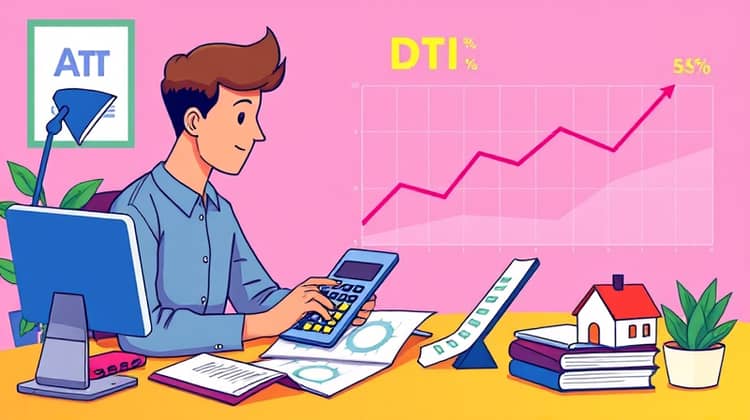Debt-to-Income Ratio 101: A Simple Guide to Master Your Finances

Managing personal finances can seem daunting, but understanding the debt-to-income (DTI) ratio is a crucial first step toward achieving financial stability. The DTI ratio is a financial measure that lenders use to assess an individual's ability to manage monthly payments and repay debts. A strong grasp of your DTI not only helps you with obtaining loans but also allows you to strategize better for your financial future.
In this guide, we will delve into the significance of the debt-to-income ratio, how to calculate it, and explore various types of DTI ratios, along with practical ways to improve your financial standing. Whether you are a first-time homebuyer, looking to refinance an existing loan, or simply trying to improve your overall financial health, understanding your DTI will serve as a solid foundation for informed decision-making.
As we dissect each component of the DTI ratio, we will equip you with essential knowledge that empowers you to take control of your finances. So, let's embark on this journey to financial literacy, beginning with a clear definition of what the debt-to-income ratio entails.
What is Debt-to-Income Ratio (DTI)?

The debt-to-income (DTI) ratio is a financial metric that compares an individual's total monthly debt payments to their gross monthly income. It is expressed as a percentage and is widely used by lenders to evaluate a borrower's ability to manage their debt load. A lower DTI ratio indicates that a smaller portion of income is dedicated to servicing debt, which is generally perceived as a sign of better financial health.
To calculate your DTI ratio, you add up all your monthly debt obligations, including credit cards, student loans, car payments, and mortgage payments, and then divide this total by your gross monthly income. Understanding your DTI is vital because it gives insight into your financial situation and can impact your chances of securing loans or favorable interest rates.
In essence, the DTI ratio helps you understand how much of your income is tied up in debt. A high DTI may signal to lenders that you might struggle to make future payments, while a lower DTI suggests that you have more financial flexibility.
Why DTI Ratio is Important?

The DTI ratio is a crucial metric that lenders examine when deciding whether to approve a loan application. By assessing this ratio, lenders gauge the risk associated with lending money to borrowers. A lower DTI ratio reflects a lower risk, making it easier for consumers to secure loans at lower interest rates.
Additionally, personal finance experts recommend keeping your DTI ratio low to ensure financial health. This metric serves as a guideline for individuals to help them manage their debts effectively. Knowing your DTI ratio enables you to make informed decisions about taking on additional debts or loans.
- Indicators of financial risk for lenders
- Guidelines to assess personal financial health
- Impact on loan approval and interest rates
By monitoring your DTI ratio, you can stay on top of your financial commitments and make necessary adjustments if you're edging toward a high DTI that could jeopardize your borrowing ability.
How to Calculate Your DTI?

To calculate your DTI ratio, start by gathering all of your monthly debt payments. This includes your mortgage or rent payments, credit card bills, car loans, student loans, and any other debts that require monthly payments. Summing these amounts will give you your total debt obligations for the month.
Next, determine your gross monthly income. This is your total income before deductions such as taxes and retirement contributions. If you have multiple sources of income, include all of them to arrive at the accurate gross figure.
With both values in hand, the DTI formula is quite simple: DTI = (Total Monthly Debt Payments / Gross Monthly Income) x 100. This calculation will yield your DTI ratio as a percentage, providing a clear view of how your debts compare to your income.
- List all your monthly debt obligations.
- Calculate your total monthly debt payments.
- Determine your gross monthly income.
- Use the formula to compute your DTI ratio.
This straightforward method allows you to gain insights into your financial health and is a vital step in planning for future expenses and potential loans.
What is a Good DTI Ratio?

A good DTI ratio typically falls below 36%, with 28% of that dedicated to housing expenses. A DTI below 36% is often seen as favorable by lenders because it indicates that you’re not overextended in terms of debt. However, specific thresholds may vary based on the lender and the type of loan being applied for.
As a general rule of thumb, the lower your DTI ratio, the better. A lower ratio means that more of your income is available for savings, other expenses, or emergency situations, which reflects on your overall financial stability. Additionally, a DTI below 20% suggests that the individual lives within their means, while a ratio above 40% raises a red flag for lenders.
It's essential to keep in mind that DTI is just one aspect of your financial profile. Other factors such as credit score, employment history, and overall income are also crucial components that lenders evaluate when considering a loan.
Understanding the average range for DTI ratios provides a benchmark for individuals looking to borrow or manage their finances.
Types of DTI Ratios

There are two main types of DTI ratios that individuals should understand — front-end DTI and back-end DTI. Each type plays a slightly different role in evaluating an individual's financial situation and loan eligibility.
Having a grasp of these two types is crucial, as they provide further insight into which debts are affecting your DTI ratio and how it can be improved.
Front-End DTI
Front-end DTI is calculated using only housing-related expenses, such as rent or mortgage payments, property taxes, homeowner association fees, and insurance. This ratio specifically looks at the portion of income that goes towards housing costs and is vital for ensuring that an individual can maintain homeownership without becoming financially burdened.
Lenders typically look for a front-end DTI ratio of 28% or less, indicating that the borrower is likely to manage their housing expenses without straining their finances.
- Includes only housing-related expenses
- Assesses affordability of housing
- Lenders prefer 28% or less
By keeping your front-end DTI ratio within these limits, you can better position yourself for favorable mortgage terms, ultimately leading to a more manageable financial situation.
Back-End DTI
Back-end DTI includes all monthly debt obligations—housing expenses and other debts like credit cards, car loans, and student loans. This ratio provides a complete picture of an individual's overall debt load relative to income and is crucial for lenders assessing the borrower's capacity to handle various obligations.
Typically, lenders look for a back-end DTI ratio below 36%. However, some may go up to 43% for certain loan types under specific circumstances, making it important for borrowers to understand their debt levels comprehensively.
- Includes all debt obligations
- Gives a complete financial picture
- Lenders prefer 36% and above 43% may be acceptable in some cases
Maintaining a healthy back-end DTI ratio enables you to enhance your borrowing potential and manage your overall financial commitments effectively.
How Lenders Use DTI Ratio

Lenders use the DTI ratio as one of the primary metrics to determine the creditworthiness of borrowers. A lower DTI means the potential borrower is more likely to pay back the loan without defaulting, making them a safer investment for lenders.
In essence, the DTI ratio helps lenders evaluate whether applicants have the financial ability to take on additional debt, determining how much they are willing to lend and at what interest rates.
- To assess creditworthiness
- To determine loan amounts and terms
- To mitigate lending risk
Thus, understanding and managing your DTI ratio is crucial for anyone looking to borrow, ensuring that you maintain financial flexibility while also meeting lender requirements.
Ways to Improve Your DTI Ratio

Improving your DTI ratio is an achievable goal and can significantly enhance your chances of loan approval. Start by reducing your debt levels, as this will directly influence your monthly obligations and, consequently, your DTI ratio. Making extra payments on high-interest debt can be an effective strategy to decrease your overall obligations. Additionally, consider consolidating debts to cheaper options or refinancing existing loans to lower payments.
Another effective method is to increase your income. Seeking out additional sources of income, whether through overtime at work, a part-time job, or side gigs, can help boost your gross income and lower your DTI ratio even with the same debt levels.
- Pay down existing debt aggressively.
- Consider debt consolidation or refinancing.
- Increase your monthly income by finding additional work or side jobs.
By continuously working toward these strategies, you can enhance your financial health and create a more favorable DTI ratio that appeals to lenders.
Conclusion

Understanding the debt-to-income ratio is essential for anyone looking to master their finances. Whether you are planning to apply for a loan or simply aiming to gain better control over your financial situation, a solid knowledge of your DTI will guide your decisions and enhance your financial wellbeing.
By keeping track of your DTI ratio and striving to improve it, you set yourself on a path towards financial success, making it easier to achieve your financial goals in the long run.






